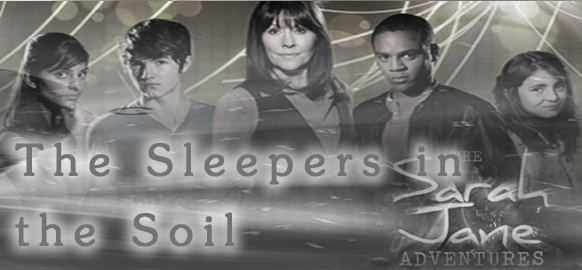
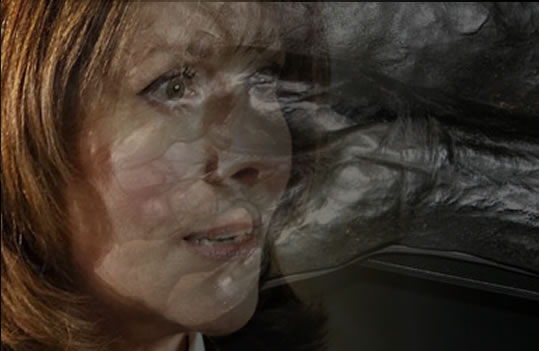
The archaeological dig at Malton Woll had been off limits to locals and press since the first spade was dug into the ground. At first the very secrecy attracted a crowd of onlookers standing outside the fenced off perimeter, gazing at the plastic tents erected over the trenches and providing toilets and rest facilities for the crew. Eventually, the press found other stories to chase and most of the locals remembered they had other places to be.
The unseasonably inclement weather on the July morning that Sarah-Jane Smith visited the site, at the special invitation of her son, Luke, saw off all but one last hanger on, a man with callipers on his legs and a crutch who glared at the ‘VIP’ visitor with such vehemence that she immediately stopped feeling sorry for his disability.
“Who is he?” she asked as they passed into the main tent where the rain noisily battered the plastic roof and rivulets of ground water slid under the rubber mats the archaeologists were kneeling on as they gently dug into the soil in their patient search for artefacts.
“He’s called Jacob Anson,” Luke answered. “He’s a bit of a nuisance. He once had some credibility in the archaeological world. He wrote a couple of books about Anglo¬-Saxon blood sacrifices in Norfolk in the nineteen eighties.” He paused and considered his slightly clumsy phrasing. “I mean he wrote the books in the nineteen-eighties, not that the Anglo-Saxons were doing sacrifices, then.”
Sarah-Jane recalled some of the odd things that she found going on in small villages in that decade. Nothing would have surprised her.
“Anyway, Anson considered himself the local expert, and I suppose he feels slighted that he hasn’t been allowed to take part in the dig, but it is a university-funded project and the department heads considered that his work was just too sensationalist and not academic enough.”
“Too much emphasis on the blood?” Sarah-Jane guessed.
“Not just that. Five years ago he wrote another book which went on about alien influences on the local tribes. He claims there are symbols on artefacts found in Norfolk that match not only ancient Egyptian hieroglyphs but also Mayan art, the Nazca lines of Peru, and Australian aboriginal figurative paintings.”
“And the academic world doesn’t tend to take alien interference in Earth history seriously?” Sarah-Jane smiled knowingly.
“Yes, I know, your memoirs would be a wake-up call to all of them,” Luke teased. “But even you would have to be sceptical of Anson. He is one of those people who likes to fit the facts to his theory not the theory to the facts. Anyway, he’s not allowed in and that’s that.”
“Well, as long as he doesn’t go rusty standing out there. How typical… the gorgeous weather all through June, and as soon as I come for a look at what you’re up to the heavens open.”
“It makes working under the tent bearable,” said Pieter, Luke’s best friend since his first undergraduate year. “You cannot imagine how hot it was in here with the sun beating down. But never mind that. Come and see the prize find.”
Sarah-Jane had already been told that Human remains had been discovered. That was the main reason for the tent work. People were just too ghoulish when ‘bodies’ were mentioned. These days they were even sending up drone cameras to try to get sneaky photographs of the interesting stuff.
She expected skeletons. After all, it was over a thousand years since these people were buried. She was unprepared for the sight of the perfectly preserved bodies, albeit blackened by years in the soil, lying at the bottom of a six or seven-foot deep trench.
“Mummified?” she queried as she looked down at the three corpses, one clearly female, the other two males. The female still had vestiges of very long hair – the straggly tresses reached down to her hips - and the two men clearly had shoulder length hair and beards.
“It’s quite common when bodies are buried in peat bogs,” Luke explained. “Well preserved bodies have been found in Ireland, Denmark, Germany to name a few. These are the best fully fleshed examples since Cashel Man, found in Laois, Ireland, in 2011. But that one was inadvertently damaged by agricultural machinery. These are fantastically intact.”
Sarah-Jane was a little worried about the dehumanised way her son talked about Human bodies as if they were no more than historical artefacts like the spears and shields that lay on a folding table nearby. But perhaps that was how you had to behave in these kinds of situations.
She looked at the figures again, noting the surprisingly calm expressions on the blackened faces. They seemed to have been buried in some majesty. Male and female alike wore bracelets and torques of precious metal and the lady had anklets, all of which had been left on the bodies while the excavation continued around them. The clothes were decayed, but they were clearly made of very rich fabrics.
“Very rich,” Pieter confirmed, showing her a sample packet with some glittering fibres within. “The gown worn by the lady was made of spun gold.”
“That can’t have been comfortable to wear,” Sarah-Jane remarked. “I had a gold lame jacket in the late seventies, and it was so scratchy.”
“Anglo-Saxons go back a bit further than the disco era, mum,” Luke remarked.
“Yes, I know, cheeky. Do you have any clue about who they are and why they were buried here? What killed them?”
They hadn’t been decapitated or had their skulls caved in, or any other signs of violence.
“We’re working on the theory that they were the tribal equivalent of royalty at the moment,” Pieter said. “But we won’t know how they died until they are sent back to Cambridge for a full autopsy. At the moment they are being preserved in situ while we examine everything around them. When they are moved into suitable containers….”
“Coffins?” Sarah-Jane queried.
“No, not really,” Luke explained. “Coffins don’t do anything to stop decomposition. We’re getting special containers that will keep the bodies at the same temperature, humidity and acidity level that they have been preserved in for the one and a half millennia they’ve been here.”
“The parish priest and a local druid both want to do their versions of prayers for the souls of the dead,” Pieter added. “And Mr Anson is about ready to hit one of us over the head with his crutch to get a glimpse. But none of them will have a chance. The lady and her attendants will be travelling in a sealed security van. Nothing can be allowed to contaminate the evidence.”
“Evidence?” Again Sarah-Jane thought it was all a bit too dehumanised.
“We think the organs are fully preserved,” Luke explained. “On site x-ray show the stomach and everything still in place. We might be able to find out what they last ate, and if anything they ingested might have poisoned them. We’ll get DNA, of course. We want to get locals to volunteer for testing, to see if they might be descendants. It’s all really exciting.”
“Yes, it is,” Sarah-Jane agreed. “Amazing.” She watched a young woman photographing the three bodies with all the attention to detail and multiple angles of a fashion photographer. “Surely you must have got enough photos by now?”
“That’s Sophie Marr. She’s responsible for the image archive. She’s taken pictures hourly to see if there is any change due to exposure to the air, ambient temperature and so on.”
“Hourly seems a bit excessive,” Sarah-Jane mused. The lithe young photographer clambered out of the trench taking two rungs of the ladder at a time. Sarah-Jane recalled being that agile herself, once. She had wormed her way through narrow conduits, climbed scaffolding up the side of rockets, done a whole lot of running.
Those were the days.
Luke introduced her to Sophie Marr who reacted with undisguised enthusiasm.
“Miss Smith, I’ve read so many of your articles,” she said. “Luke has mentioned you often, of course. If I said he takes after you for conscientious attention to detail in his work, I suppose he would blush….”
Luke DID blush. Sarah-Jane sought for a way to turn the conversation to something less personal. Fortunately, Sophie had her own agenda.
“May I show you something, Miss Smith? I know I’m surrounded by experts, but I could do with a fresh pair of eyes, somebody open minded but with attention to detail who can confirm that I’m not going dotty.”
“I’m not sure I’m the person to talk to on that account,” Sarah-Jane remarked. “I’ve doubted my sanity many times.”
Sophie smiled indulgently and insisted that she would like to pick Sarah-Jane’s brains. She suggested coffee and a sit down in the refreshment tent.
This facility was under a separate canvas roof with a large groundsheet to keep feet dry. A mismatched selection of garden furniture made chairs and tables for drinking coffee or tea served from two big portable hot drink dispensers. Sophie brought coffee and two individual packs of biscuits to a table before opening the portfolio she brought with her.
The pictures were of the three bogs bodies. At first they looked much alike, but as Sarah-Jane studied them she realised there were distinct differences.
“They’ve got the preservation wrong,” she said. “The bodies are getting darker, shrivelling….”
She paused in thought. She had seen these bodies only a few minutes ago. She had noted how relaxed, peaceful, the expressions were. They weren’t tight and stretched into grimaces of death as the skin contracted.
She studied the images again then glanced up, questioningly, at Sophie.
She had been looking at the pictures in the wrong order. Which meant...
“You see it too, don’t you?” the young archaeological photographer said.
“It looks as if the bodies are gradually becoming more… alive….”
“Nobody else seems to have noticed. It’s so gradual, they wouldn’t. But when I look at the pictures taken at intervals it is obvious.”
“Except that isn’t possible, of course.”
“Absolutely impossible.”
“Mmm.” How many impossible things had she seen in her life, Sarah-Jane wondered? But mummified bogs bodies reviving was an incredulity too far.
“It must be the light… or something.”
As an explanation that was as weak as they come. Sarah-Jane shook her head even as the words came out of her mouth.
“At least I know I’m not going mad,” Sophie reasoned. “You’re new to the dig, neutral, as it were, and you see it, too.”
“I see it. I’m just not sure what anyone can do… or should do.”
“Maybe this is normal. Maybe there’s something that wasn’t understood about the nature of bog mummification….”
Sophie shook her head. No, there was nothing normal, natural, that explained the fact that shrunken flesh, tight across the skeleton, was starting to look plump and fresh.
Their musings were cut short by a commotion outside. Sarah-Jane heard Luke’s voice raised among others and the parental instinct kicked in. She rushed out to see what trouble her son was in.
The problem was Mr Anson. He had forced his way through the perimeter and was trying to get into the main tent. Luke and Pieter were among those trying to stop him going any further.
“It’s important,” he remonstrated. “I have to talk to somebody. You don’t know what you’re doing. The Sleepers… you cannot let them rise. I know. I know what they mean to do.”
“Mr Anson, you’re not making sense,” Luke told him.
“Find me an ADULT who will listen, not a bunch of kids,” he retorted.
“I’m an adult, and I’ll listen,” Sarah-Jane told him. “Luke, bring Mr Anson to the tea tent. He can tell me what he has to say.”
“And who might you be?” Anson asked, partly mollified.
“I’m Sarah-Jane Smith. I’ve had a lifetime of listening to people like you, Mr Anson. I’ve always been ready to listen to the most remarkable stories, but I also know a total crackpot when I hear one. I’ll give you the benefit of the doubt as long as you stop shouting at my son and his friends and conduct yourself like a gentleman.”
Pieter began to protest that Mr Anson was not allowed on any part of the site, but that was academic. He had already crossed the line. Taking him quietly to the refreshment tent was easier than forcing him back outside where he would surely carry on making his noisy protest.
In the tent, Sarah-Jane assumed command. She sent Luke to get teas all round while Sophie carefully put away her photographs, holding the portfolio carefully away from Mr Anson’s gaze.
“Now,” she said when the tea was served. “Mr Anson, start at the beginning.”
“It began in 1982,” he responded. “When I was a student involved in the first dig in these parts.”
1982. Some years Sarah-Jane had a hard time recalling, but 1982 stood out. That year was all about Harry – good luck messages on Forces Radio when he was sailing to the South Atlantic on the Canberra, being there at Southampton when the ship returned, discovering that friendship was a stronger and longer lasting tie than something fast burning and fleeting….
She was young, then. They all were. Mr Anson must have been Luke’s age – a ‘kid’ who could be easily dismissed by his elders and betters.
And that had been half the problem.
The other half was lack of credibility.
“We were digging about fifty metres from here. Just fifty metres. It was my first dig but it had been so boring I almost gave up on archaeology. All we found were a few bits of pottery.”
“Sometimes a few bits of pottery are the most important find of all,” Luke pointed out. “Do you want to be like the man who was searching for Troy - Heinrich Schliemann. He blasted through the ruins of the city he was looking for trying to find ‘’treasure’ in the older levels. Archaeology is patient, meticulous and sometimes disappointing.”
Sarah-Jane smiled at her son.
“Next time The Doctor drops by ask him about meeting Flinders Petrie. But back to you, Mr Anson. What was it that happened in 1982?”
“That was when the Sleepers first tried to contact me. It was only a sensation then – as I walked in the field I felt something touch me. Something that told me that we ought to be digging in this place, not where we were wasting our time. I tried to tell the people in charge, but they laughed at me. They said the dig was based on scientific research, not ‘feelings’ and that I would never amount to anything unless I applied myself seriously.”
“So….”
“So I applied myself seriously. I became one of the top men in the field. I wrote two books about Anglo-Saxon customs in Norfolk. I was respected. I came here many times, and the contact was stronger. They actually spoke to me. They told me they were waiting to be found by us… by the people of this age. And I tried. I sought permission to dig here. But this land belonged to the church and the vicar of the time – Reverend Southold - would not allow it. He said that it was a heathen place and should not be tampered with by godly men, and if there were bodies they were of damned souls that should not be unearthed.”
“Bit of an old fashioned kind of attitude, even for a vicar,” Sarah-Jane observed. “But if he was responsible for the land, he had the right to say no.”
“I saw him there, often, praying, trying to quell the spirits. But they weren’t souls that a Christian prayer could touch. And I knew. I knew he had heard them, too. When he was on his deathbed, I visited him and he told me the truth. He told me what the Sleepers really were.”
“And what are they?” Sarah-Jane guessed the answer before Anson spoke again. “Don’t tell me, alien beings?”
“Don’t mock.”
“I wasn’t mocking. You wrote about alien influences on the local tribes. It stands to reason. Assuming both you and the old vicar aren’t both delusional what else could it be?”
“Aliens. They were treated as royalty… no… not just that… as living gods… by the local tribe. It was all because of their beauty. Anglo-Saxons were hardened people, their faces tanned by working under the sun, hands calloused by labour. Even their women were nothing to look at with rough skin, ragged hair and bad teeth. These beings came among them with fair skin and golden hair, perfect features, tall, lithe bodies, and they were entranced. The tribe paid tribute to them. They made beautiful jewellery to adorn them. But something went wrong. A harvest failed or something. The tribe turned against their gods. They held a great feast and poisoned them. They were buried with all of the proper rites. What the tribe didn’t know was that you can’t kill a god – or an alien. They just hibernate or something of the sort… protected by the soil around them. They slept for a millennia and a half, only starting their long, slow waking in the last half century.”
“And the dig finished the job?”
“The dig! It was only because of my many applications to explore this area that those fools from Cambridge knew where to look. They got permission from the diocese without the old Reverend objecting. But they shut me out. They wouldn’t listen. They thought I wanted ‘treasure’ when all I wanted was to warn them.”
“Warn them?”
“Of course, warn them. Do you think the messages I or the Reverend heard were benign? Do you think I wanted to dig up the graves when they were still in their deep sleep in order to welcome them to our modern world, to worship them again as gods? I meant to destroy them while it was still possible, before it was too late.”
“They’re dangerous?” Sarah-Jane asked. “But they didn’t harm the tribe they came to in the past?”
“But the tribe harmed them. And they have had all that time to plot revenge. They have the power to cause great harm to a people who are so convinced now of their own godlike superiority they will waste precious time disbelieving their own eyes instead of striking them down.”
“No!” Luke jumped up from the table so abruptly the mostly untouched cups of tea sloshed over. “Pieter!”
He ran from the refreshment tent. Sophie dropped her portfolio and ran after him. Anson glanced at the photographs that spilled over the table, some of them coming into fatal contact with the tea, but enough of them remaining for him to see what Sarah-Jane had already seen.
“It’s happening, now. They’re reviving. They cannot….”
He, too, rushed away as well as a man with callipers and a crutch could rush. Sarah-Jane sighed deeply as she followed. All this running around was all very well for the younger generation. She hadn’t voice n managed to FINISH a cuppa with all these histrionics.
She reached the dig tent in time to witness the scene Anson had feared. The ‘Sleepers’ were very much awake. The two men and a woman stood beside the trench where they had lain for fifteen hundred years.
They looked magnificent. The woman was tall and slender with straw-yellow hair falling loose to her thighs. Her face had a healthy peaches and cream complexion with green eyes that glittered in the lamplight. Her golden dress was regenerated with her body and so was her jewellery. She looked every inch a queen.
Whether the two men were her consorts or possibly her sons was not clear, but they, too, looked regal in leather and bronze. They flanked her with stern expressions on their rehydrated faces.
Pieter was standing before them. He was trying to block them from leaving the tent.
“Do not defy us,” the queen said to him in a voice sweet as honey yet full of malice. “We are greater than any puny Human. Our power is unparalleled.”
“You don’t scare me,” Pieter answered, though he was probably lying. The queen laughed harshly and raised her hand. A glowing white ray shot out from her fingers and would have caught Pieter square in the chest if Luke had not pushed him out of the way and took the blast himself.
Sarah-Jane’s scream was the loudest, though Pieter’s as he grasped hold of Luke’s falling body was a close second.
“No, he’s all right,” Sophie murmured as the cries subsided. “He’s alive. He’s moving.”
Sarah-Jane knew that already. She had run to her son’s side and was grasping his hand while Pieter cradled him in his arms. Luke coughed and breathed in deeply. His eyes opened widely and he looked at his friend and his mother.
“They’re not all powerful, yet,” he whispered. “They’ve used up a lot of energy just getting out of their graves. They haven’t got enough power to kill, yet.”
“Well… I’m glad about that,” Sarah-Jane said through tears of relief. “But….”
She looked up and saw Jacob Anson limping up behind the Sleepers. Nobody, least of all the three aliens, had taken any notice of a crippled old man in the midst of such drama. The Sleepers didn’t see him raise his crutch and use it like a club to smash in the back of the queen’s skull. As she fell, face forward, into the trench where she had lain for so long, Sophie Marr grabbed a turf cutting spade and swung it at the nearest of the two male Sleepers. It might have been a lucky strike rather than carefully aimed, but the sharp edge of the spade sliced part of the way through the Sleeper’s neck. At the same time, another of her colleagues grasped one of the bronze spears that had been retrieved from the grave. That found its mark in the stomach of the second male Sleeper.
Sarah-Jane gasped in shock at the three acts of violence that happened around her as she clung to her son. Sophie dropped the spade and she, too, gasped in stunned amazement at what she had done in the spur of the moment. The young man who had thrown the spear was almost in tears.
Jacob Anson was calm, leaning on his crutch only because he was a cripple who needed to do so, not out of any emotional need for support. He looked down into the trench at the three bodies that lay there, not buried with all rites, this time, but as they fell, one of them still skewered by his own ancient spear.
“Look,” Anson said firmly. “You, boy, stop wailing and look. You, too, girl. Look at them.”
Sophie and her colleague stepped close to the trench and looked down.
Sarah-Jane, Luke and Pieter stood shakily and looked down, too. What they saw was astonishing, though maybe not as astonishing as it perhaps ought to be.
The three bodies were blackened and leathery, faces tightly drawn over their skulls. They looked as they had looked when they were first unearthed except they now bore signs of violent death. The woman’s skull was broken, one man had been partially decapitated, the other speared through his abdomen.
And the wounds looked as if they had been done more than a thousand years ago when they had first been buried. There was no evidence that they had been living beings a few minutes ago and had been cut down before they could gather the terrible powers they claimed they had.
“We didn’t REALLY kill them,” Sophie managed to say. “They weren’t really alive.”
“They were alive,” Anson told her. “Don’t try to justify it that way. They were alive and they were dangerous and we had to stop them. It was self-defence. It was to stop them being a threat to our world. We did what had to be done.”
“He’s right,” Sarah-Jane agreed. “Nobody needs to feel any guilt or grief. Just be glad it’s all over.”
“What do we tell people?” asked Sophie.
“Nothing,” Sarah-Jane continued. “When those containers arrive, send the bodies to Cambridge for autopsy just as planned. I suspect the cause of death might be easier to work out than you first thought, and you might not be able to claim that these are the most perfect mummified bog bodies ever found, but otherwise nothing about this dig has changed. Carry on doing what you’re doing. Write your papers about Anglo-Saxon burial rites and everything.” She glanced at Anson who shook his head in a resigned way. “Best leave anything about aliens out of it if you want to get anywhere in professional archaeology.”
The young graduates, still coming to terms with what seemed almost a surreal dream, now, all nodded, slowly, as they realised that Sarah-Jane was right.
She stood up slowly, helping Luke to his unsteady feet. She noticed that Pieter still clung to his hand.
“Now,” she said. “I think I’m going to see if I can get an uninterrupted cuppa and a chat with my son and his friend about how they’re so willing to throw themselves into harm’s way for each other. I’m starting to think somebody needs to tell me something.”
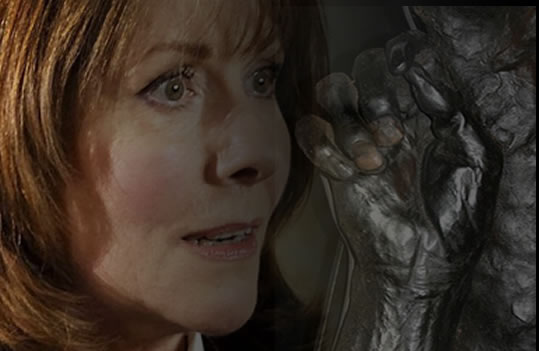
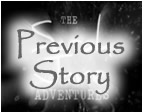 |
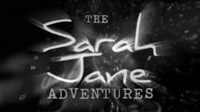 |
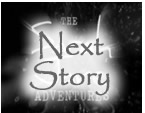 |